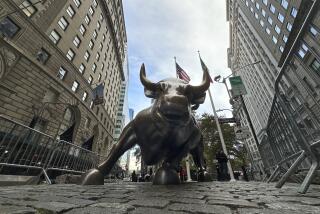‘Program Selling’ Hits Stock Market; Dow Industrials Plunge Record 41.91 Points
- Share via
NEW YORK — Stock prices plunged in active trading today, and the Dow Jones industrial average took its biggest single-day point drop in history.
The Dow Jones average of 30 industrials dropped 41.91 to 1,783.98. It was the biggest one-day loss ever in terms of points, eclipsing the old mark of 39.10 points set Jan. 8, 1986, when the average fell to 1,526.61.
But in terms of value of the average, today’s drop represented a 2.3% decline, compared to a 2.5% decline on Jan. 8.
Losers swamped gainers by four to one on the New York Stock Exchange.
The NYSE’s composite index dropped 2.66 to 135.75.
At the American Stock Exchange, the market value index fell 3.28 to 268.97.
Few sectors were spared in the sell-off. Analysts said the losses were intensified by “program trading,” computer-driven trading systems designed by big investment firms to profit from differences between stock prices and stock index futures.
Eagerness to collect profits made on stocks that have surged with the overall market since last autumn contributed to the setback.
The market may have entered a period of what analysts call consolidation, in which stocks that have already climbed in value pause or pull back a bit while others catch up.
Analysts say stock prices may send out confusing signals until a clearer picture emerges about the economy’s health and the course that interest rates will take in the months ahead.
The latest report on the U.S. trade performance implied American manufacturers have yet to feel much benefit from the declines in the dollar and interest rates.
The Commerce Department said the U.S. trade deficit swelled to $14.5 billion as imports of manufactured goods surged to an all-time high and the country suffered a record deficit with Japan.
The dollar’s depreciation against other major currencies is expected to make American goods more competitive with rival foreign goods, but any improvement in the country’s trade performance will not occur for quite a while, analysts say.
Another government report said orders to U.S. factories for manufactured goods fell 2.3% in March, the second decline in a row and the biggest drop in almost two years.
Bond prices were mixed in quiet trading early today as the credit markets awaited the Treasury’s announcement of details of its May refunding operation.
Analysts have estimated that the Treasury would detail a package of notes and bonds totaling from $24 billion to $26 billion.
In recent days, interest rates have moved higher amid concerns that the sharp drop in the dollar could curb Japanese interest in the U.S. securities market, a crucial point with the upcoming flood of Treasury securities. But the dollar has stabilized over the past several days, and many traders have said those concerns have dissipated.
In the secondary market for Treasury bonds, intermediate maturities fell in the range of 1/8 to 13/32 point, and long-term issues declined by as much as 22/32 point. Short-term governments were unchanged, according to the investment firm of Salomon Bros.
The movement of a point is equivalent to a change of $10 in the price of a bond with a $1,000 face value.
The Merrill Lynch daily Treasury index, which measures price movements on all outstanding Treasury issues with maturities of a year or longer, rose 0.08 to 118.99. The Shearson Lehman daily Treasury bond index, which makes a similar measurement, fell 1.33 to 1,239.95.
In corporate trading, industrials rose point in active trading and utilities were unchanged in light activity.
In trading among tax-exempt municipal bonds, general obligations were unchanged in light activity, and dollar bonds fell point in moderate trading.
More to Read
Inside the business of entertainment
The Wide Shot brings you news, analysis and insights on everything from streaming wars to production — and what it all means for the future.
You may occasionally receive promotional content from the Los Angeles Times.










